- トップページ
- 日本国内での取り組み
- JICA関西
- 「人」明日へのストーリー
- Report on JICA/KCCP-ILEC training and how I integrated and contextualized the ILBM training concept to my Action Plan.

Organization: Rift Valley Lakes Basin Development Office、Ethiopia Basin Development Authority
Name: Mr. Zinabu Abrham Lera
Position: Environmental and Water Quality Monitoring Expert
Name of Program: Integrated Lake, River and Coastal Basin Management for Sustainable Use and Preservation of Water Resources
Background
My name is Mr. Zinabu Abrham Lera and I work as an Environmental and Water Quality Monitoring Expert in the Ethiopia Basin Development Authority Rift Valley Lakes Basin Development Office. The Integrated Lake Basin Management (ILBM) concept was first brought to my attention through a team from the Japan International Cooperation Agency (JICA Ethiopia) that had visited my Office in Hawassa Ethiopia. I then applied and was invited to join a JICA training Program in Japan for two months. The training was very beneficial and enabled my organization to play an active role in coming up with tangible ways to help address some of our lake environment problems,particularly in seven Rift Valley Lakes (Ziway, Abijata, Langano, Shalla, Hawassa, Abaya and Chamo Lakes).

Lake Hawassa view
At the end of my training, I was required to come up with an action plan. I hope to be able to help future participants in developing their own action plans through this report. In this report I highlight the aspects I identified during the JICA training which helped me identify my action plan. I am glad that I also got an opportunity to participate in a JICA-JETAA follow up program in Addis Ababa where I was able to report on progress, challenges and lessons learnt after the JICA training. I endeavor in this report to do the same and highlight how the training has benefited me and the organization I represent for the betterment of our lake environment.
Link:

Lake Hawassa is blessed with tourism resources and fishery and ecosystem function for environment.
Continuous Formulation of Action Plan
During the two month JICA- ILEC training we went through lectures, field visits and hands on training on issues pertaining to Integrated Lake Basin Management. The training was an eye-opener as I realized that some of the aspects were possible to do and or improve through my organization and our Basin. The Rift Valley Lakes Basin Development office at the time of my JICA training had three main thrusts, namely, Lake Basin Planning, Basin Research and Data management service. So the first question was how to integrate and promote the ILBM concept into these three already existing thrusts so that we could come up with better manage our lake environment. More specifically, what new things from the JICA training could be integrated into our Lake Basin Planning, Basin Research and Data management service thrusts as an Organization.
Action Plan 1: Reviving Water Quality Monitoring Program
During the ILBM training, the importance of well-resourced laboratories and water quality monitoring program was emphasized especially during the Lake Biwa Museum and Kyoto University of Environmental Research Centre tour. The Water Resource Management Department initial review revealed the absence of industrial and domestic wastewater quality data for the Rift Valley Lakes Basin, so a small number of sampling sites were identified to monitor water resources pollution status.
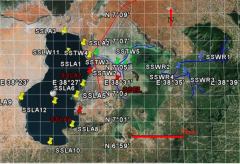
Spatial distributions of water quality monitoring stations in Lake Hawassa watershed.
Actually, this monitoring station was focused on main rivers and doesn’t take into account many rivers, tributaries and water source (reservoirs) as well as their characteristics in baseline, flux, trend and impact station and can’t assess real time data which plays a key role in classifying water quality level.
This situation explains the lack of scientific series and data analysis for waters resource in rift valley lakes.

Team for Rift Valley Lakes Basin, Strategic Basin Plan which synthesizes ILBM Concept with existing IWRM.
Reviving and helping to enhancing and establishing real time water quality monitoring program, Data and information thus became my first action plan. We have since formed a water quality monitoring team which is involved in assessment, designing station for water quality and research in the real-time water quality monitoring and helping to revive it. Efforts to establish real-time water quality monitoring program are still on going. The real-time water quality monitoring program is also used for policy maker, decision maker, researcher and holding real-time data management demonstrations when conducting ILBM concept related courses.
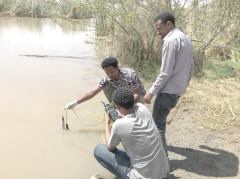
Seasonal water quality monitoring at the feeder river of Lake Ziway.
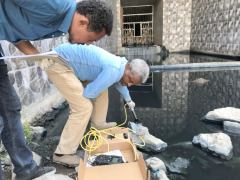
Water quality monitoring of industrial effluent.
Action Plan 2: Synthesis of the ILBM Concept for Strategic Lake Basin Planning
During the JICA training participation, informative research and monitoring was highlighted as an important aspect in Lake Basin management. Lessons learnt during the JICA training was used to formulate and inspire strategic lake basin plan that would reflect efforts towards improving our water resource and lake environment. The plan prepared for the coming 15 year in the area of water resource management, water quality management, integrated watershed management, active participation of all stakeholder, climate change and invasive species all taught during the JICA training. Since participation and information services were already part of the core corporate of my department and organization. This was done through development of awareness and training for key stakeholders such as industries, different water users, organizational and non-organizational water use sector and cities. This also involved integrating the ILBM concept in different stage of strategic lake basin planning document. The material acquired during the JICA training is being used as synthesizing the ILBM platform.
The organization has since prepared four sub basins and one compiled basin wide plan document on issues linked to lessons learnt from the ILBM concept. The basic essence of this synthesis strategic basin plan is to provide a comprehensive document that addresses all components of the ILBM and the existing IWRM and subsequently improved by universities, industry and research under the modality of university industry linkage.
Action Plan 3: Capacity building
JICA-ILEC training highlighted the need for capacity building. The action plan was thus meant to capacitate more team members from my organization in knowledge of the ILBM Concept. This was done by sharing material (printed and soft copies) and lessons learnt during the JICA training. The materials provided have been used by some colleagues in their PhD studies, MSc and to improve their learning material. Capacity building is an on-going process and is important for all stakeholders involved in Lake Basin management.
Conclusion
The JICA-ILEC training was beneficial and very practical. In formulating the Action Plan, it is good to identify the areas that your organization is able to contribute significantly. Implementation of the action plan may require adjusting once you are on the ground but the overall goal of helping to improve the lake environment should not be lost. It is also good to evaluate your progress after a given period. Thank you to JICA for the opportunity to take part in the training and the follow up program.




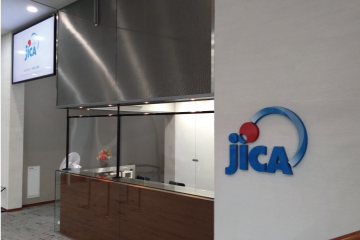

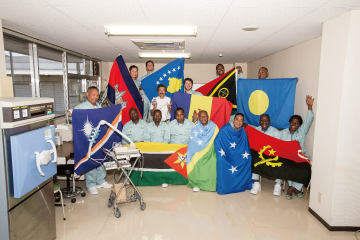






scroll